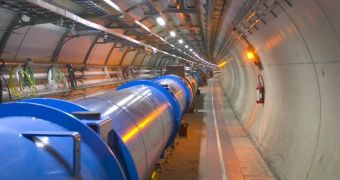In spite of the fact that the 27-kilometer-long Large Hadron Collider (LHC) was built in order to further our understanding of particle physics, and also to discover the elusive Higgs boson, engineers and physicists are also planning other uses for it. In the near future, one such purpose may be to test the validity and the efficiency of a novel class of spacecraft-propulsion systems, namely the hyperdrive engines, Technology Review reports.
The influential German mathematician David Hilbert first proposed an interesting side-effect to Albert Einstein's theory of relativity in 1924. In a book entitled “The Foundation of Physics,” Hilbert analyzed in great detail the interactions of a relativistic particle, as it was moving towards or away from a stationary mass. He determined that, to the inertial, distant observer, a particle traveling at more than half the speed of light would appear to be repelled by the stationary mass. US-based physicist Franklin Felber says that this idea has more or less been forgotten since, but adds that it could still do wonders.
Felber has also performed calculations of his own, showing that, if Hilbert's theory is true, then relativistic particles should also repel stationary masses under the same conditions. This allows the particles to essentially deliver a specific impulse that is greater than its specific momentum, which means that it basically achieves speeds greater than the driving particle's speed. He says that this “hypervelocity propulsion” principle is similar to observations made on the elastic collisions of a heavy mass with a much lighter, stationary mass. The latter moves away at two times the former's speed.
By placing a test mass next to a high-energy particle beam inside the LHC, and using resonant test mass, Felber believes that the largest particle accelerator in the world could determine whether his ideas are false or correct. The expert adds that Fermilab's Tevatron is equally well suited for such a test, and argues that there is nothing to lose in trying new ideas. He reveals that none of the test masses placed alongside the beams in either of the accelerators will have any ill-effects on the ongoing acceleration experiments.

 14 DAY TRIAL //
14 DAY TRIAL //